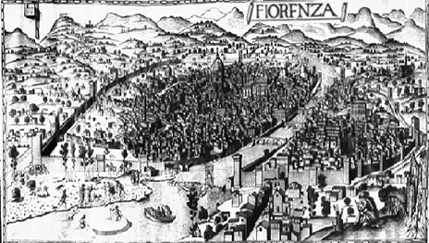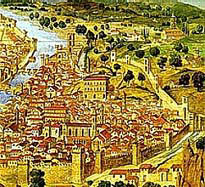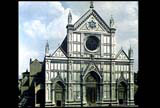Florence

Significance within the Decameron:
Stories:
Emilia: First Day, Sixth Tale (In which the rich man exposed the hypocrisy of the inquisitor)
Pampinea: Second Day, Third Tale (A nephew of three men who squandered their wealth falls in love with and eventually marries the daughter of the King of England)
Filostrato: Third Day, First Tale (Lamporecchio pretends to be dumb and acquires work at a nunnery and access to the nuns inside)
Filomena: Third Day, Third Tale (A noblewoman uses an innocent friar as a go-between for her affair with a local man)
Panfilo: Third Day, Fourth Tale (Friar Puccio, a pious man, is told how to attain blessedness, thus paving the way for Dom Felice to have an affair with his wife)
Emilia: Third Day, Seventh Tale (Tedaldo, thought to be murdered by the hand of his mistress' husband, reappears and saves her husband, and also the affair)
Emilia: Fourth Day, Seventh Tale (Simona, accused of murdering her lover, Pasquino, who died by rubbing a poisonous sage leaf on his teeth, can only clear her good name by dying herself)
Neifile: Fourth Day, Eighth Tale (Girolamo, in love with Salvestra, is convinced by his mother to go to Paris, only to return to find her married to another)
Fiammetta: Fifth Day, Ninth Tale (Federigo degli Alberighi wins the woman he loves, at the cost of his beloved falcon)
Filomena: Sixth Day, First Tale (Madonna Oretta is badly told a story, by a man promising a ride through a tale, and asks to be let down)
Pampinea: Sixth Day, Second Tale (Cisti the baker wins the friendship of Geri Spina with good wine and a quick remark)
Lauretta: Sixth Day, Third Tale (Monna Nonna replies to a jibe of the Bishop of Florence)
Neifile: Sixth Day, Fourth Tale (Currado Gianfigliazzi's cook, Chichibio, steals a stork leg)
Panfilo: Sixth Day, Fifth Tale (Giotto replies to Rabatta's unkind remark)
Fiammetta: Sixth Day, Sixth Tale (Michele Scalza proves the Baronci are the noblest family, not just in Italy, but the world)
Elissa: Sixth Day, Ninth Tale (Guido Cavalcanti shames the men taunting him with a quick remark)
Emilia: Seventh Day, First Tale (Gianni Lotteringhi's wife chases away a "werewolf" with a prayer)
Filomena: Seventh Day, Seventh Tale (Madonna Beatrice takes Lodovico as a lover, and her husband receives a beating)
Neifile: Seventh Day, Eighth Tale (Monna Sismonda's jealous husband beats the maid and cuts off her hair, thinking she is his wife)
Panfilo: Eighth Day, Second Tale (The priest of Varlungo goes to bed with Monna Belcolore and gets out of giving her what she asked for)
Elissa: Eighth Day, Third Tale (Calandrino is fooled into thinking he has found the rock of invisibility, only to have the spell broken by his wife)
Filostrato: Eighth Day, Fifth Tale (Three men pull down the pants of a judge)
Filomena: Eighth Day, Sixth Tale (Bruno and Buffalmacco steal a pig from Calandrino and make it appear as though he himself had stolen it)
Pampinea: Eighth Day, Seventh Tale (A scholar, made a fool by a widow, pays her back in full)
Lauretta: Eighth Day, Ninth Tale (A Bolognese doctor is tricked by Bruno and Buffalmacco.
Fiammetta: Ninth Day, Fifth Tale (Calandrino, believing a woman is in love with him, is discovered in a compromising position by his wife)
Lauretta: Ninth Day, Eighth Tale (Biondello and Ciacco play tricks on each other)
Fiammetta: Tenth Day, Sixth Tale (King Charles magnanimously refrains from taking advantage of his host's daughters and instead bestows them in marriage)
Major Florentine Characters:
Cisti the Baker
Geri Spina
The Baronci Family
Calandrino
Bruno and Buffalmacco
Other Images of Florence:

Woodcut of Florence's city walls

A View of the Duomo.

Image courtesy of the University of Calgary, the Catena - 1470.

Map of Florence in 1913 (1.0 MB). Image courtesy of the The Perry-Castañeda Library Map Collection at The University of Texas at Austin.
Pertinent data:
General Aspects: It is surrounded by gently rolling hills that are covered with villas and farms, vineyards and orchards. The city became a very important cultural center. The Florentine vernacular became the Italian language; and the local coin, the florin, became a world monetary standard. Italian legendary writers such as Boccaccio and Dante came from Florence.
Political Aspects: The political life of a Florentine in the 13th and 14th centuries was usually governed by the party with which one chose to align himself. In the 13th century the two warring factions were called the Guelfs and the Ghibellines, while in the 14th century the fighting was between the Black and White Guelphs.
Cultural Aspects: The 13th century was a time of great cultural flowering for Florence. The economy was booming and much money was spent on the arts and entertainment. Giotto, one of the forefathers of naturalism in painting, flourished during this period.
Major Locations:
Built by the Dominicans, Santa Maria Novella is the meeting place of the brigata. The image is courtesy of Tulane University.
Santa Croce, begun in 1294-5 by Arnolfo di Cambio, is a Franciscan church built at the same time as the Santa Maria Novella. This image also is courtesy of Tulane University.
(J. K., J. Q. & N. F.)

